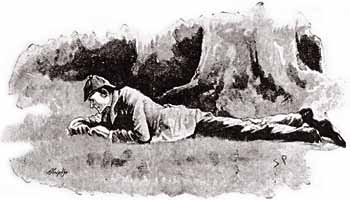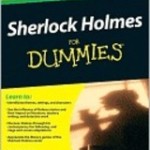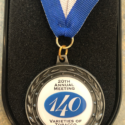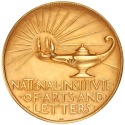A Scion Society of The Baker Street Irregulars

Data! Data! Data! – The Boscombe Valley Mystery
“‘Data! Data! Data!‘ he cried impatiently. ‘I can’t make bricks without clay.’”
– The Adventures of The Copper Beeches (COPP)

This column is composed of material (Data!) developed for a short course called Appreciating Sherlock Holmes that I taught twice a year in the Community Education Life Enrichment Program for a local community college. It is composed of “points of information” that are common to many / most / all of the 60 Canonical stories.
The information here has been researched by me or borrowed / stolen from many efforts of other Sherlockians.
HERE GOES The Boscombe Valley Mystery
 CHRISTOPHER MORLEY SAID . . .
CHRISTOPHER MORLEY SAID . . .
“Air and scenery perfect” was the allure that Holmes used to tempt Watson to accompany him to the countryside in the West of England where murder had been committed. The crime had its origin in far-off Australia, and Watson (who had been in the country) might have been quicker in recognizing some of the clues.
DUMMIES SHORT SUMMARY (From Sherlock Holmes for Dummies by Steven Doyle & David Crowder)
“It’s murder! Here Holmes uses his powerful forensic crime-scene investigation skills.”
PUBLISHING HISTORY
· This is the 6th of the 60 stories in published sequence
· It was first published in The Strand Magazine in October, 1891
· It is part of The Adventures of Sherlock Holmes collection by George Newnes, Ltd., London, 1892 and Harper Brothers, New York, 1892
· The British illustrator was Sidney Padget
HOW MANY WORDS?
According to C. E. Lauderback, 1960 – – found on SHERLOCKIAN.NET website created by Chris Redmond and at 9,681 words, BOSC has the 45th most words (#1 is VEIL – 4,499, #56 if NAVL – 12,701)
THE BEST OF SHERLOCK HOLMES (How do Sherlockians rate this story?)
1999 – The Baker Street Irregulars voted it 28th of the 56 short stories
1999 – The Sherlock Holmes Society of London voted it 35th of the 56 short stories
CLASSIFYING THE CASE (From the Wandering Gipsies of Grimpen Mire of Decatur, Alabama)
This case is one of 23 classified as a MURDER where the perpetrator was wither killed, arrested, or otherwise satisfactorily handled. And it is one of 4 where Holmes let the perpetrator go free. The others were ABBE, DEVI, and VEIL.
CHRONOLOGICALLY SPEAKING
Doyle was often very vague about stating WHEN the tale took place and included few contemporary references to help. Whether this was done intentionally or unthinkingly, the dating of events in the Canon is a very popular pastime pursued by several of our “scholars” researching and justifying their results to no end. We will again default to William Baring-Gould’s dating of Saturday June 8 and Sunday June 9, 1889. Chronologically speaking this makes it the 22nd of the 60 stories in time. This makes Holmes 35 and Watson 37.
WHAT ELSE HAPPENED IN YEAR 1889?
It is always interesting to see what else in happening at the same time as the stories.
· British South Africa Company Charter awarded.
· Transvaal claimed to be “encircled” by Rhodes’ concessions in East Africa. Rhodesia established.
· Great London Dock Strike; the “Dockers’ Tanner”; growth of unskilled workers unions; New Unionism; Gasworkers’ Union formed.
· March 30, Early used of photographs in newspaper: Illustrated London News runs Cambridge and Oxford boat crews.
· Woolwich Ferry starts.
· Act to prevent cruelty to children.
· Technical Education Act: County Councils to levy 1d for technical and manual education.
· Establishment of telephone company.
· Board of Agriculture becomes government department with minister.
· General Booth (Salvation Army) publishes Survey of London Life and Labour.
· Japan’s Meiji constitution.
· Italy takes Somalia and Ethiopia.
· The Moulin Rouge first opens its doors.
· North and South Dakota, Montana and Washington admitted as U.S. states.
· Treaty of Acciali: Ethiopia made Italian protectorate.
· End of Portuguese Empire in Brazil; republic proclaimed. Abdication of King Milan of Serbia; accession of Alexander.
· Paris Exhibition: proof of industrial development in France.
· Brunner-Mond Salt Union formed; combine of 64 firms.
· Work on Panama Canal stopped; French company bankrupt.
· Bismarck introduces Old Age Insurance in Germany.
· Erection of Tacoma Building in Chicago. First skyscraper, 13 storeys high.
· Sir James Barrie’s A Window in Thrums, sketches of Scottish village life.
· Conan Doyle publishes A Sign of Four.
· Mark Twain publishes A Connecticut Yankee in King Arthur’s Court.
· Robert Louis Stevenson publishes Master of Ballantrae.
· Dvorak presents Symphony No. 4 in G major.
· Gilbert and Sullivan present The Gondoliers.
· Renoir paints Girls Picking Flowers.
· Van Gogh paints Man with a Pipe (self-portrait), The Olive Grove.
· Cezanne paints Harlequin.
· Eiffel Tower completed, 985 feet high, taller than the Great Pyramid, becomes the highest structure on earth.
· Hollerith’s punched-card system widely used in industry.
· Eastman’s Kodak camera comes into production, using photographic film.
· First linotype machine in use.
· Panhard and Levassor begin using Daimler’s engines in French cars, using modern layout.
HOLMES AND WATSON – PERSONAL INFO
Holmes is residing at 221B but Watson is married and in practice, living with his wife.
DRAMATIS PERSONAE
· JOHN TURNER, wealthy landowner in Boscombe valley. Made his money in Australia.
· ALICE TURNER, his 18 year-old daughter.
· CHARLES McCARTHEY, the murder victim. A tenant farmer on Turner’s best farm. Knew Turner in Australia.
· JAMES McCARTHEY, his son. In jail and accused of the murder.
· WILLIAM CROWDER, a gamekeeper. Saw the two McCartheys pass within a few minutes of each other just before the murder
· PATIENCE MORAN, 14 year-old daughter of the lodge-keeper. She saw the two McCarthey’s arguing just before the murder.
· OLD WOMAN, no name given. Also saw the two McCartheys pass within a few Minutes of each other.
· LESTRADE, hired in a private capacity by Alice Turner in the hope that he could clear James of the charges.
· DR. WILLOWS, attending John Turner for his diabetes.
· BARMAID, of Bristol. Secretly married (?) to James McCarthey.
“QUOTABLE SHERLOCK”
All these quotes are from Holmes to Watson
· “It is really very good of you to come, Watson,” said he. “It makes a considerable difference to me, having someone with me on whom I can thoroughly rely. Local aid is always either worthless or else biased.”
· “Singularity is almost invariably a clue. The more featureless and commonplace a crime is, the more difficult it is to bring it home.”
· “Circumstantial evidence is a very tricky thing,” answered Holmes thoughtfully. “It may seem to point very straight to one thing, but if you shift your own point of view a little, you may find it pointing in an equally uncompromising manner to something entirely different.”
· There is nothing more deceptive than an obvious fact.”
· “I cudgelled my brains” – Watson. Note: Watson also cudgelled his brains in The Naval Treaty.
· “You know my method. It is founded upon the observation of trifles.”
HOLMES’ FEE
No mention
SHERLOCK ON THE BIG SCREEN & THE LITTLE SCREEN
1922 The Boscombe Valley Mystery With Eille Norwood as Holmes and Hubert Willis as Watson is not lost – The National Film and Television Archive at the BFI has viewing copies of this film but it has not been released
1968 The Boscombe Valley Mystery was an episode in the BBC TV series with Peter Cushing as Holmes and Nigel Stock as Watson.
1991 The Boscombe Valley Mystery was an episode in the Granada series with Jeremy Brett as Holmes and Edward Hardwicke as Watson.
SHERLOCK HOLMES IN DISGUISE
The Master of disguise used the deception of being disguised 14 times in 11 of the 60 stories, but none were used in this story.
UNRECORDED CASES (That involved Holmes)
Watson would tease / torture his readers with “I know something you don’t.” Oh my, how Sherlockians love this category. I have in excess of over 150 examples in my collection but neither Holmes nor Watson mentioned any here.
FAINTING IN THE CANON (courtesy of Sherlockian Karen Murdock)
Fainting is extremely common in the Canon, appearing, in some form, in 37 of the 60 tales. In 21 cases someone actually faints. In 22 cases someone almost faints. And in 5 cases someone pretends to faint. But, in this tale, no one faints, almost faints, pretends to faint, or even mentions fainting.
HOLMES’S PUBLISHED & PROJECTED WORKS
Sherlockians love this topic and are regularly searching for these items. Holmes mentions published or projected works in 11 of the stories. This story mentions Holmes’ epic Upon the Distinction between the Ashes of Various Tobaccos which had been published
IS THERE A DOCTOR IN THE HOUSE?
Victorian London, in the Holmes’ time, had approximately 1 doctor for every 100 people. 31 of the 60 tales have a doctor in them. This, of course, does not count Holmes’ Boswell. This listing is by Leslie Klinger in the Winter, 2015 edition of the Baker Street Journal. In this story have 3 doctors mentioned
· Anstruther – a locum tenens available to Watson, possibly by his “accommodating neighbor” – also mentioned in FINA and STOC
· Dr. Willows – John Turner’s treating physician
· Unnamed surgeon who examined McCarthy’s body for the inquest
NEWSPAPERS (Real and Fictional)
Though included in only 20 tales some of our more obsessed Sherlockians love this one. No mention of the press by name in this tale.
ANNOTATED SHERLOCK
The 60 Sherlock Holmes stories used English as spoken in England from the 1880’s until the 1910’s. Some words are foreign to us today and need a “contemporary translation.”. For example, our story has
· “métier” – French: trade, profession.
· “Nous verrons.” – French: “We shall see.”
· “assizes” – Assize courts were the superior courts in each county which held sessions to determine civil and criminal cases twice a year. Were abolished in 1972.
WEAPONS (from A Compendium of Canonical Weaponry by Dettman and Bedford)
… “a means by which one contends against another” … utilized in 57 of the 60 tales (all but CREE, 3STU, & YELL) There are several general categories to classify “weapons” that include: firearms, human agents, cutlery, animals, blunt instruments, extortion, toxin, blackmail, and miscellaneous. In our story, which is short, you will find all of the following:
· Gun (probably shotgun) – Which James McCarthy had with him during a violent argument with his father, and which the police thought he had used to bash in his father’s skull, thus terminating the spat.
· Firearms – Which the Ballarat Gang in Australia used during their robbery of the gold convoy during their robbery of the gold convoy from Ballarat to Perth, killing three troopers guarding the shipment.
· Firearms – Which the troopers guarding the convoy fired at the robbers, felling two of them.
· Pistol – Which John Turner, a member of the gang, used to cover the wagon driver of the convoy, Charles McCarthy, this winning the day for the robbers.
· Rock – Lying beside Boscombe pool, which John Turner used to murder Charles McCarthy
· Threat – Of informing to the police, used by Charles McCarthy on John Turner, because of Turner’s past associations with the Ballarat Gang.
 Frank Mentzel, aka Merridew of Abominable Memory, has been catching up on reading some of the books he has and is trying to decide what to wear for Halloween when the neighborhood kids come to his home for trick or treating.
Frank Mentzel, aka Merridew of Abominable Memory, has been catching up on reading some of the books he has and is trying to decide what to wear for Halloween when the neighborhood kids come to his home for trick or treating.



